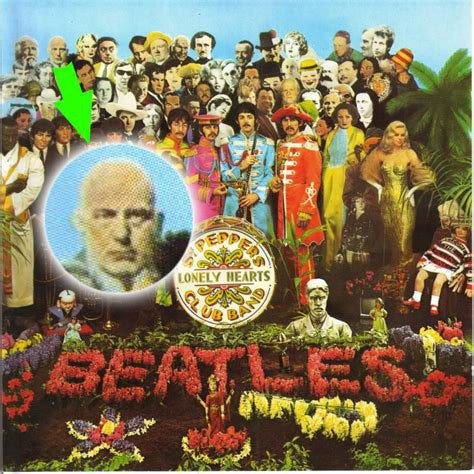The Unholy Subversion of the Music Industry
How musical masons wrote the soundtrack to modern Babylon
Since every single boomercon and their grandma has voiced their outrage over what’s now being called the “Satanic Grammys”, I was reluctant to write about it at first. After an initial viewing, I didn’t really notice anything esoteric to point out during Sam Smith’s performance as it didn’t adhere to the typical occult formula of hiding symbols in plain sight. This was certainly in plain sight, but not at all hidden, which is actually what stood out to me most. I had also recently seen a post about how The Weeknd does similar blatantly Satanic rituals during his performance and even flashes the name of Satan on the big screen.
While there are pop performers who are actual occultists; I suspect many are just useful idiots, industry slaves who are dressed up, handed music and choreography, forced to do their song and dance, and MK Ultra’d into compliance by their occultist handlers through drugs and sex. We know this to be the case more definitively from the recent exposé on celebrity fitness trainer Harley Pasternak who was the handler of Ye West, Mac Miller, Brittany Murphy and Lady Gaga among others. But is there something even more nefarious at play here? Why are these entertainment industry controllers so aggressively anti-Christian?
The reason for these types of performances mocking Christianity and mimicking Satanic rituals is itself part of a larger ritual that goes back almost 100 years. This greater Masonic song and dance ritual isn’t only the work of the pop artists themselves, but one crafted by their owners. In its most recent iteration, a mockingly explicit display of homosexuality has coincided with overtly Satanic themes. For example, the 2021 music video “Montero”, a song written by the same Israeli producer who wrote Sam Smith’s “Unholy”, featured rapper Lil Nas X as a literal gay demon descending into hell on a stripper pole then giving Satan a lap dance. It resulted in national outrage by Christians, which was later ridiculed in his live performance at the 2022 Grammy’s.
These performances serve multiple purposes. They make a mockery of the Christianity that has hindered their “true spiritual enlightenment” and create revolutionary Luciferian “light bringer” archetypes of the performers themselves while demoralizing the public. But it’s also a historically proven, effective business model to generate free publicity by sparking outrage. Since it began, the modern entertainment industry has been guided by the Luciferian spirit through the Gnosticism of Freemasonry and Jewish mysticism. As John Lennon once said in an interview, “Show business is an extension of the Jewish religion.”1
The Jewish influence of the entertainment industry began on Broadway, which for the first 50-year period of its development, its songs were created almost exclusively by Jews. As they say in Monty Python’s Spamalot, “You won’t make it on Broadway if you don’t have any Jews”. However, Jewish songwriting has not only rooted itself into Broadway style musicals but also in jazz, pop music, R&B, rap and even some of the most popular American Christmas songs.
Irving Berlin was a highly influential Russian Jewish immigrant composer and Freemason who adapted to early 19th century American culture so well that he wrote the most popular Christmas song, “White Christmas”, the most popular Easter song “Easter Parade”, obviously neither having anything to do with the birth of Christ or His resurrection. Berlin also wrote "God Bless America" in 1918, which became such a well-loved conservative anthem that it nearly replaced the national anthem. But it was also met with protest from several Christian groups once the song had reached mainstream success because they found out it was written by a Jewish immigrant.
George Gerswhin, a descendant of Russian Jews, was a highly influential songwriter and Freemason, famous for his 1935 Broadway play called Porgy & Bess where a cast of black performers were made to debunk the Bible while singing the lyrics “it ain’t necessarily so, the things that you're liable to read in the Bible, it ain’t necessarily so!”. This line was lifted directly from the Jewish liturgy, as one is called up to read from the Torah in the temple, a blessing is made with the words “Bar'chu et adonai ham'vorach”. Gershwin replaced the lyrics with “it ain’t necessarily so”.
Broadway, Hollywood and American culture back then were at least on the surface a lot less sinister and without any overt displays of Satanic imagery. Many of the great jazz pioneers were black Freemasons and introduced marijuana and heroin into the musical arts in the 1920s, which led to Henry Anslinger launching the war on drugs. By the 1950s, Jewish music and Freemasonry had established a strong influence on early jazz for decades and thus fused the long relationship between blacks and Jews in the music industry that is present to this day. But the more obvious anti-Christian displays really start becoming prominent in pop music in the 1960s with the classic John Lennon interview in March 1966 where he famously stated,
“Christianity will go. It will vanish and shrink. I needn’t argue about that; I know I’m right and I will be proved right. We’re more popular than Jesus now. I don’t know which will go first—rock & roll or Christianity."
This resulted in nationwide Beatles album burning gatherings led by evangelical church groups. The following year, The Beatles’ manager Brian Epstein would die due to a drug overdose, but the band went on to reach the height of their success with their best selling albums releasing in their later years.
More notably, the number 1 best selling Beatles album, “Sgt. Pepper’s Lonely Hearts Club Band” featured an image of Freemason occultist and British intelligence agent Aleister Crowley, who’s occult mysticism was so influential that it essentially became the prominent spiritual philosophy of the pop culture artists themselves. This is when the shift towards a more blatant expression of Luciferianism became evident in the music industry.
With bands like Black Sabbath and KISS (acronym for Knights In Satan’s Service), a more noticeable showing of unconcealed Satanic symbolism really started being introduced to the mainstream through the heavy metal genre, influenced by Church of Satan founder Anton LaVey, since its inception in the 1960s. In metal, it was a practically indistinguishable blend of both a Satanic aesthetic meme and actual Satanism. It contributed to the largely justified “Satanic Panic” of conservative Christians but much like what happened with The Beatles, the controversy only led to further success and album sales, strengthening the case that offending Christians is an effective marketing scheme.
Throughout the 1980s, this ritualistic cycle of Satanism and sexuality followed by inevitable outrage from Christians, continued to prove itself as a successful business formula to generate album sales. As they say, there’s no such thing as bad publicity. After the PMRC senate hearings ruled in favor of music censorship, the famous parental advisory labels backfired by adding an extra selling point by advertising that those albums had explicit content.
The 1980s also brought about the first appearances of blatantly anti-Christian themes in pop music with Madonna, who happens to be a famously devout Kabbalist and even got a tree of life tattoo on her wrist. Madonna’s blasphemous “Like a Prayer” music video resulted in Pope John Paul II calling for a worldwide ban on all her sponsors. “The controversies leading to her 'Like a Prayer' music video introduced the concept of free publicity and became a turning point where Madonna was viewed as a shrewd businesswoman who knows how to sell a concept”2. This also began the normalized over-sexualization of pop music, which alongside drug usage and Luciferian individualistic philosophy, has become its primary identity to this day.

Why is it that Christianity is the only religious worldview that has been consistently mocked and subverted in the entertainment industry, whether in the more subtle forms in the early 20th century, or in its current, glaring forms that we see today? All we are seeing currently in the entertainment industry is the same Jewish revolutionary spirit that was there since the beginning. It’s just evolved into more obvious forms as generations became more successfully demoralized. Throughout the history of modern pop culture there has been a consistent underlying Crowleyan “do what thou wilt” philosophy accompanied by raw hedonistic individualism, along with Kabbalistic self affirmations such as “be your true self”.
It is part of the larger ongoing black magic spell in itself to slip the mask off and perform these blasphemous rituals to shock the public, a proven method that has stood the test of time to generate free publicity just like John Lennon, Madonna, and a slew of heavy metal artists did before. Author Michael W. Ford has written on Lucifer as a "mask" of the adversary, a motivator and illuminating force of the mind and subconscious.3 In it’s current state, depicting hypersexualized forms of homosexuality has become as essential to this new version of Kabbalistic theater as the curtain call. Transcending oppressive sexual barriers through Kabbalistic “sex magick” is necessary to advance toward what Albert Pike calls the “Luciferian path”.
With the confirmation from Ye West about how the entertainment industry is rife with MK Ultra slave performers being controlled and manipulated by Jewish and masonic industry executives, Sam Smith’s performance at the Grammys showed us that the performer himself does not even need to be a practicing witch or flashing Masonic symbols. It revealed that behind artists like Sam Smith and Lil Nas X are secret controllers who are exploiting him to progress their Luciferian agenda towards “true enlightenment”. In fact, whoever is running the CBS Twitter account even acknowledged the ritual as Satan worship, then later deleted the Tweet. Promotional trickery, mask off moment, or perhaps both?
Luciferianism is the hidden spiritual philosophy of Freemasonry and Jewish Kabbalah. As occult philosopher and highly influential 33rd degree mason Manly P. Hall said in his book The Lost Keys of Freemasonry,
“The true Mason is not creed bound. He realizes with the divine illumination of his lodge, that as a Mason his religion must be Universal. Christ, Buddha or Mohammed. The name means little, for he recognizes only the light and not the bearer.”
The basic Luciferian principles highlight truth and freedom of will, worshipping the inner self and one's ultimate potential, and to encourage and celebrate the same within all.4 It makes no difference who the performer is, what matters to the Luciferians is that ultimate illumination is achieved. For that to happen, any remaining Christian influence must be destroyed, then Babylon can be rebuilt with the shekels earned from its downfall.
Just remember, Christ wins in the end.
If the world hates you, you know that it hated Me before it hated you. If you were of the world, the world would love its own. Yet because you are not of the world, but I chose you out of the world, therefore the world hates you.
John 15:18-19
John Lennon "Showbusiness is an extension of the Jewish religion", Internet Archive, https://archive.org/details/john-lennon_202103 (Accessed Februrary 6, 2023)
Taraborrelli, Randy J., Madonna: An Intimate Biography, Simon & Schuster, 2002.
"Adversarial Doctrine", Bible of the Adversary, Succubus Productions, 2007. p. 8.
HandWiki contributors, "Philosophy:Luciferianism," HandWiki, https://handwiki.org/wiki/index.php?title=Philosophy:Luciferianism&oldid=2487939 (accessed February 8, 2023).













One thing I read is that the introduction of bass in music serves as morse code for trained ears to decipher the messages within; messages meant for government agents and initiated ones. Another thing is backmasking popularized by Crowley, reverse-engineered lyrics that contain the true message of a song, as so popularly used by The Beatles.
Amazing article, glad I discovered your work !